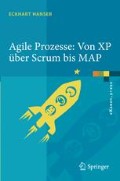Zusammenfassung
Ein Software-Prozessmodell ist ein Modell für die Entwicklung eines Software-Systems. Da Modellbildung immer auch Abstraktion beinhaltet, geht es nicht um die Darstellung des Ablaufs eines bestimmten Software-Entwicklungsprojekts, sondern einer ganzen Klasse von Projekten. Daraus ergibt sich, dass nicht jedes Prozessmodell für jede Klasse von Projekten geeignet ist. Es gibt grundsätzlich schwergewichtige und leichtgewichtige Prozessmodelle, wobei die agilen Modelle zu den leichtgewichtigen gehören.
Access this chapter
Tax calculation will be finalised at checkout
Purchases are for personal use only
Notes
- 1.
Zum Begriff des Artefakts (engl. artifact) siehe (Jacobson et al. 1999).
- 2.
Dies ist aber keine Bedingung für den Organic Mode.
- 3.
Die Entwicklung der Software in einem militärischen Projekt gehört sicherlich zu dieser Klasse.
- 4.
Dies ergibt sich alleine schon aufgrund der Größe des Teams.
- 5.
Der Begriff „leichtgewichtiger Prozess“ begegnete dem Autor zum ersten Mal in (Fowler u. Scott 2000).
- 6.
Prozessmodell entspricht eher direkten Übersetzung des engl. process model.
- 7.
- 8.
War dies doch einmal der Fall, wurde das Projekt neu aufgelegt.
- 9.
- 10.
- 11.
Bei der Entwicklung von Software für Maschinensteuerungen kam man auch weiterhin mit dem Phasenmodell aus.
- 12.
- 13.
Rational wurde 2002 von IBM akquiriert.
Literatur
Boehm B (1979) Guidelines for verifying and validating software requirements and design specifications. EURO IFIP 79, pp. 711–719, North Holland 1979
Boehm B (1981) Software Engineering Economics. Englewood Cliffs, NJ: Prentice-Hall
Boehm B (1986) A spiral model of software development and enhancement. ACM SIGSOFT Software Engineering Notes, August 1986
Boehm B (1988) A spiral model of software development and enhancement. IEEE Computer, Vol. 21, Ausg. 5, Mai 1988, pp. 61–72
Dröschel W, Wiemers M (2000) Das V-Modell 97. München: Oldenbourg
Fairley R (1985) Software Engineering Concepts. New York, NY: McGraw-Hill
Fowler M, Scott K (2000) UML konzentriert. Bonn: Addison-Wesley
Höhn R, Höppner S (2008) Das V-Modell XT. New York, NY: Springer
Jacobson I, Booch G, Rumbaugh J (1999) The Unified Software Development Process. Reading, MA: Addison-Wesley
Royce W (1970) Managing the development of large software systems. Proceedings of IEEE WESCON, Vol. 26, pp. 1–9.
Author information
Authors and Affiliations
Corresponding author
Rights and permissions
Copyright information
© 2010 Springer-Verlag Berlin Heidelberg
About this chapter
Cite this chapter
Hanser, E. (2010). Software-Prozessmodelle. In: Agile Prozesse: Von XP über Scrum bis MAP. eXamen.press. Springer, Berlin, Heidelberg. https://doi.org/10.1007/978-3-642-12313-9_1
Download citation
DOI: https://doi.org/10.1007/978-3-642-12313-9_1
Published:
Publisher Name: Springer, Berlin, Heidelberg
Print ISBN: 978-3-642-12312-2
Online ISBN: 978-3-642-12313-9
eBook Packages: Computer Science and Engineering (German Language)

